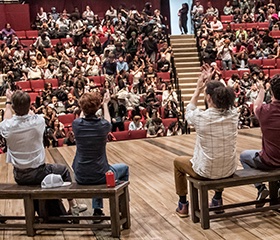It had been so long – four years – since I had attended a student performance in LCT’s Vivian Beaumont Theater that I had nearly forgotten what I’d been missing: an audience that is absolutely alive. The students from the eleven New York City schools who attended this week’s Wednesday matinee of Camelot responded with gusto to the unfolding of the tale. Toni Morrison once said that “the chief pleasure of teaching narrative is seeing how each class responds to the same story with fresh eyes.” After the student matinee, I will never again see the Lerner & Loewe musical through the same lens.
Many of the thousand or so students in the house had been prepared for the matinee through three sessions in their home classrooms. Under the auspices of LCT’s Open Stages program, directed by Kati Koerner, teaching artists explored the following topics: how King Arthur, Queen Guenevere, and the knights of the Round Table tried to move England from a philosophy of “might MAKES right” to “might FOR right”; how the emotional interaction of Arthur, Guenevere, and Sir Lancelot constitutes a Triangle of Love; and how in the musical’s second act the teenage character of Mordred, the illegitimate son of King Arthur and the scientist Morgan Le Fey, turns everything in the kingdom topsy-turvy. (The students will have a post-performance session to discuss these matters and more.)
During the exposition of story in the first act, the audience was a little more subdued than student audiences I’d remembered in the Beaumont. But in the second act, when conflicts come to a head, the students were electric. This build-up began during the second-act scene in which Arthur tells Guenevere he views her as his “business partner.” There has been some discussion of new book writer Aaron Sorkin’s decision to use that phrase. Well, the student audience knew EXACTLY what Sorkin meant with those words: the downgrading of a spouse from lover to colleague.
Subsequent to that marital exchange came the intimate scene between Guenevere and Lancelot in which the students’ response was stupendously engaged. To ride this sonic wave, the actors had to re-calibrate their balance. Being in the theater at that moment was delicious: after all, one of the chief pleasures of going to the theater is watching expert actors adjust their timing to audience response.
The students were very aware of their effect on the performers. At the post-performance talkback, facilitated by Open Stages Associate Director Alexandra López, one of the students asked the actors if they are ever tempted to break character. “I break quite easily,” responded Andrew Burnap, who plays Arthur. He added, with a grin, “Today was a real test.”
Post-performance, the students indicated their affection for the Act One swordfight scene. How does that mini-battle feel? asked a student. “It feels great,” replied Jordan Donica, who portrays Lancelot, adding: “I look forward to it every day.” Donica also said that he enjoys the scene “because I get to do it in sexy leather pants.”
While sex and romance and swordfighting may have pointed up the visceral nature of the afternoon, there was also response of a more spiritual order. “I go to church every Sunday with my family,” I overheard a student tell her friend. “I wish it was as much fun as watching Camelot.” I wanted to lean over and explain how thousands of years ago the theater grew out of religious ritual. But I restrained myself: she had had a good time and I certainly wasn’t going to spoil it.
P.S. Here are the schools whose students enlivened Camelot this week at the special performance:
Comprehensive Model School Project
High School for Environmental Studies
High School for Excellence and Innovation
High School for Health Professions
High School for Law, Advocacy & Community Justice
High School of Fashion Industries
IN-TECH Academy
Marble Hill High School for International Studies
Pace High School
Pelham Preparatory Academy
William E. Grady High School
Brendan Lemon is a freelance journalist in New York.
